When the Gross Dam was planned outside Boulder, Colo. in the early 1950s, project engineers had an idea that the population served by utility Denver Water might increase, so they designed the 340-ft-tall curved gravity dam in a way that allowed for a 120-ft raise sometime in the future.
Today, Denver Water serves 1.5 million people, more than Colorado’s entire population in 1950. The Gross Reservoir, which covers 440 surface acres and holds more than 41,000 acre-ft of water, is part of the utility’s north system that accounts for 20% of supply but just 10% of storage capacity. So it planned to raise the dam to serve the larger population, improve system efficiency and create better resilience against wildfires.
Denver Water now plans to raise the Gross Dam even higher than the 1950s engineers had imagined, by another 131 ft to 471 ft. The $531-million project would nearly triple reservoir capacity to 119,000 acre-ft—the largest raise of an existing dam using roller-compacted concrete in the world, says Felipe Garcia, senior principal at Stantec, which designed the project, along with AECOM. The record is currently held by the 117-ft raise of the San Vicente Dam in San Diego, Calif, completed in 2014.
“It’s an iconic project, a world-class project,” Garcia says.
Work led by a Kiewit-Barnard joint venture that is Denver Water construction manager/general contractor for the project, began in April 2022. The first year of construction focused largely on site development and foundation work, says Doug Raitt, Denver Water construction manager. Crews widened and improved access roads to the site, prepared pads for aggregate crushing equipment and concrete batch plants and cleared an area for soil removed for foundation excavation. They also began excavating the foundation for the dam’s expanded footprint. As of last month, Raitt says the team had about 75 ft of 500 ft to excavate on the right side, and about 150 ft remaining on the left side.
Drilling and grouting contractor Keller mobilized in April and started a foundation grouting program that is expected to last into the fall, Raitt says.
The foundation is another area on the current project that has benefitted from the forethought of the team that built the 1954 dam, according to Garcia. He says it made the foundation deep enough so the current team does not need to deepen the grouting of the existing dam for the raise. Earlier project team members also excavated beyond what was needed for the original dam to reveal a shear zone of weaker material on the upper left abutment over the crest of the dam.
It’s exactly where the structure of a raised dam would sit, Garcia says. “They left a huge, about 20-ft-tall, cut slope where you could see the actual shears yourself,” he says. “It was almost like a message from the guys in the ‘50s saying, ‘We didn’t have to deal with it, but you guys do.’”
The team is placing a concrete overlay on the rock formations to ensure the foundation is as strong as is needed for the future structure to sit on, according to Raitt.
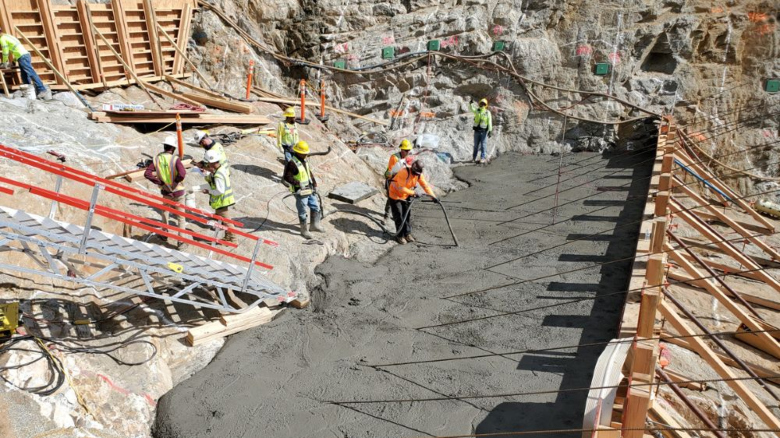 Workers place concrete in areas where weak rock was removed. Photo courtesy of Denver Water
Workers place concrete in areas where weak rock was removed. Photo courtesy of Denver Water
Preparing The Dam
Raising the dam requires the project team to widen its base by about 11 ft. Contractor WALO International is roughening the 200,000-sq-ft dam surface using ultra-high pressure hydrodemolition equipment to allow for a better bond between the old and new concrete. The team is also trimming the edges of the inset spillway to a beveled cut and removed the top 13 ft of the spillway’s ogee crest to prevent stresses from concentrating in the new structure. The work allows old and new structures to behave as one unit, Raitt says.
“It’s like an 850,000 cu yd overlay of the existing dam,” he says. “We don’t want any abrupt edges on the existing structure that would concentrate stresses in the new structure that’s sitting on top of it.”
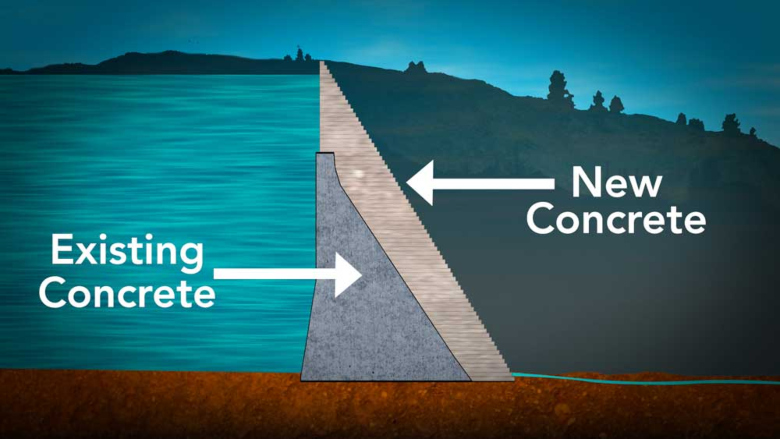 To raise the dam, Denver Water must widen its base. Graphic courtesy of Denver Water
To raise the dam, Denver Water must widen its base. Graphic courtesy of Denver Water
The new design reshapes the dam as a gravity arch that will use the canyon walls to provide the thrust reaction to strengthen the dam without making it quite as thick as a traditional gravity structure relying solely on mass, Raitt says. The 1950s design is “very compatible” with the new arch overlays, he adds.
“It makes it just a little bit steeper on the downstream face,” Raitt says. “But we do have some nice canyon walls to anchor the dam into that to give us all the strength we need with the current shape.”
Another change from the 1950s is use of roller-compacted concrete. Raitt says the process is faster than a mass concrete block approach and reduces expensive inputs such as requiring much less cement. The roller-compacted concrete cures slower but also generates less heat, giving it another advantage compared to having to cool and possibly risk cracking mass concrete. Garcia compares the method of placing it in horizontal lifts similar to building an embankment.
Roller-compacted concrete needs to be placed at a temperature close to that of the existing structure, and Raitt says the team needed concrete with a batch temperature below 45°F—provided by an ice plant that also chills aggregates, sand and batch water.
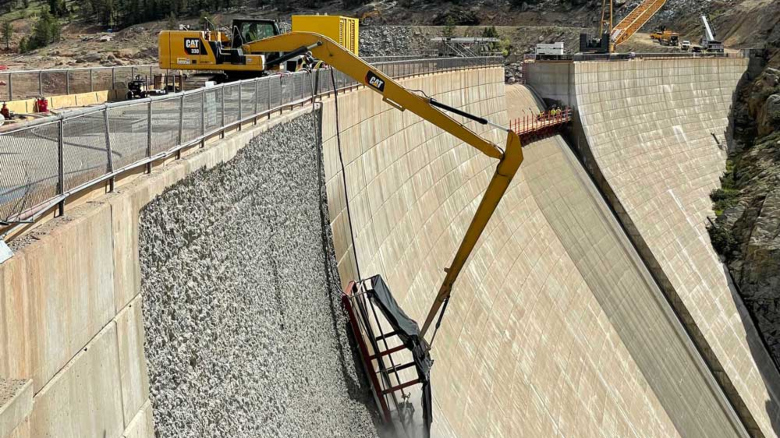 Removing the top few inches of concrete will allow for a stronger bond with the new roller-compacted concrete. Photo courtesy of Denver Water
Removing the top few inches of concrete will allow for a stronger bond with the new roller-compacted concrete. Photo courtesy of Denver Water
The project also has a batch plant for conventional concrete to be placed along the new face of the dam that offers freeze-thaw protection that the roller-compacted concrete mix does not. Raitt says that is needed at the site with an elevation of more than 7,000 ft above sea level.
That site location has added some challenges for the team. Todd Orbus, project manager for Kiewit-Barnard, compares the project to open-heart surgery because the team must work while the dam continues to operate. Plans include detailed monitoring and other measures to ensure safety and the dam’s continued operation.
“Our crews perform controlled blasting within inches of the existing dam foundation while it continues to impound over 250 ft of water,” he says.
The location’s weather can also be less than ideal. One recreation area beside the reservoir is called Windy Point, with Raitt saying the name is literal since wind there “is exceptionally strong.” Last year, most of April saw “red flag” days when crane work and blasting could not be done due to high winds.
Cold temperatures also limit the site's planned construction season, Orbus says. But some work has been able to continue during colder months, done with heating under tents, Raitt says. “Just last night, we had 3 in. of snow on the site,” he noted in April. “We had to slow things down for a couple hours this morning, but we’re back at it.”
Contracting Model
While most work was awarded to the Kiewit-Barnard joint venture, Raitt says there are still a few contracts to be advertised. A mechanical package will likely ne issued next year, followed by one for removal of trees within the expanded reservoir perimeter.
Denver Water awarded a pre-construction contract to Kiewit-Barnard so it could provide input on optimizing the design, Raitt says, adding that it has helped capture economies during the design phase and eased the process to finalize the construction package.
“Change management has been much less of a burden, because we brought the contracting team along with us,” Raitt says. Members "knew exactly what they were getting into when the design documents were approved by agencies.”
Orbus agrees that the CM/GC model and the collaborative approach taken by Denver Water and contractors “allowed us to work together as a team from the project's inception to raise a world-class dam that will provide more drinking water for generations to come.”
The project is scheduled for completion in 2027.




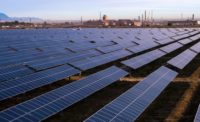
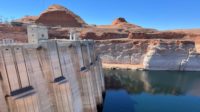
Post a comment to this article
Report Abusive Comment